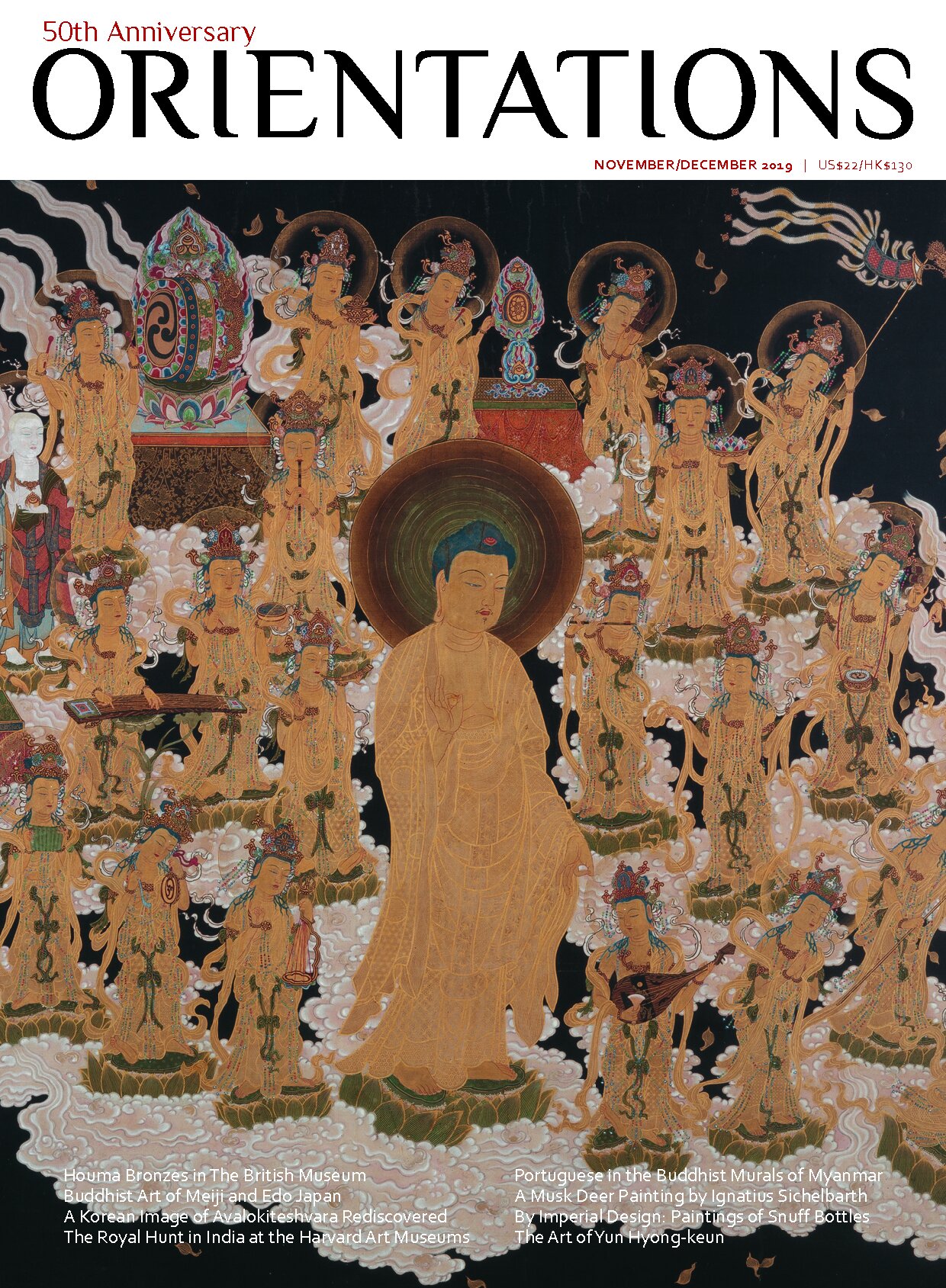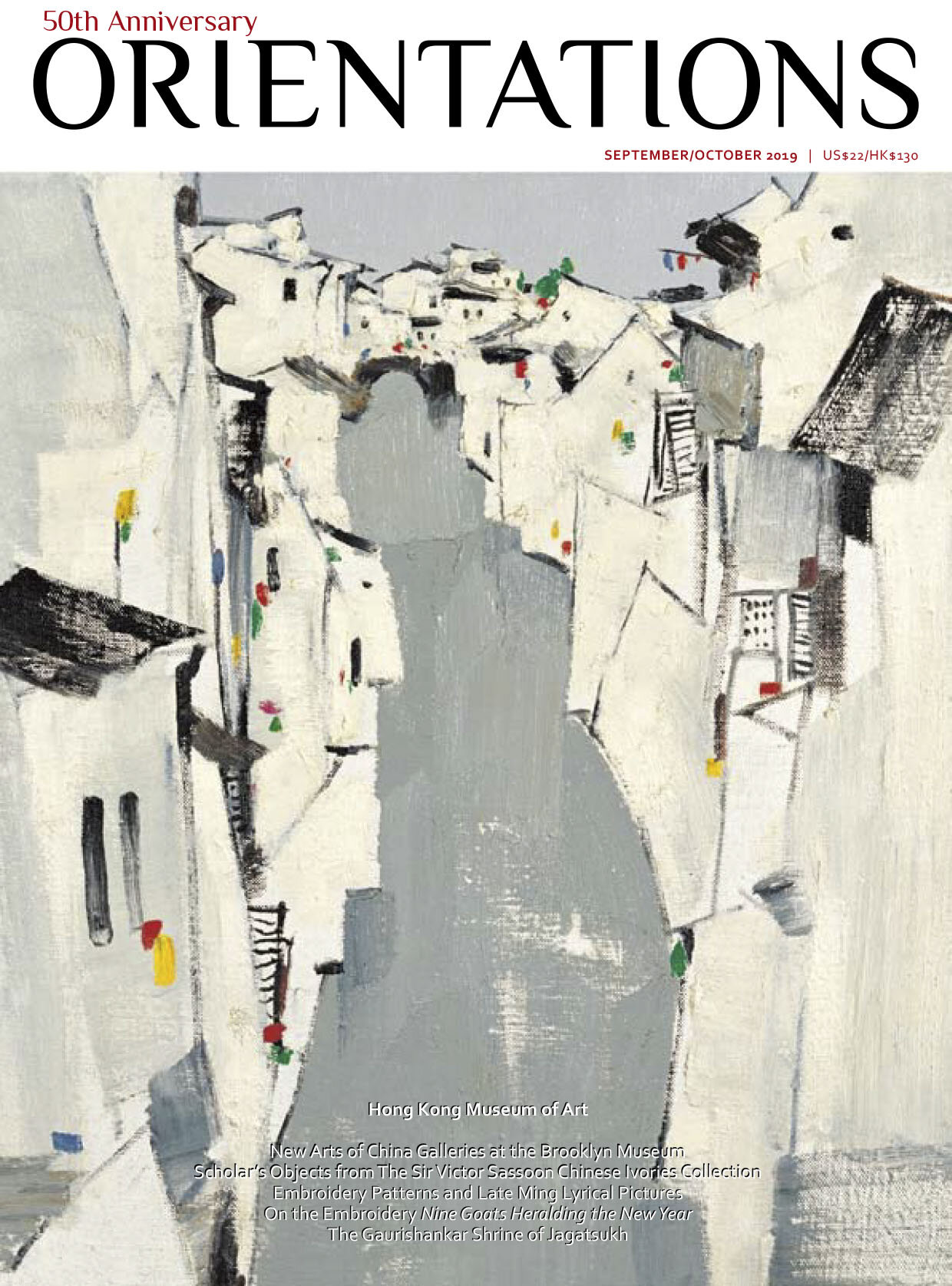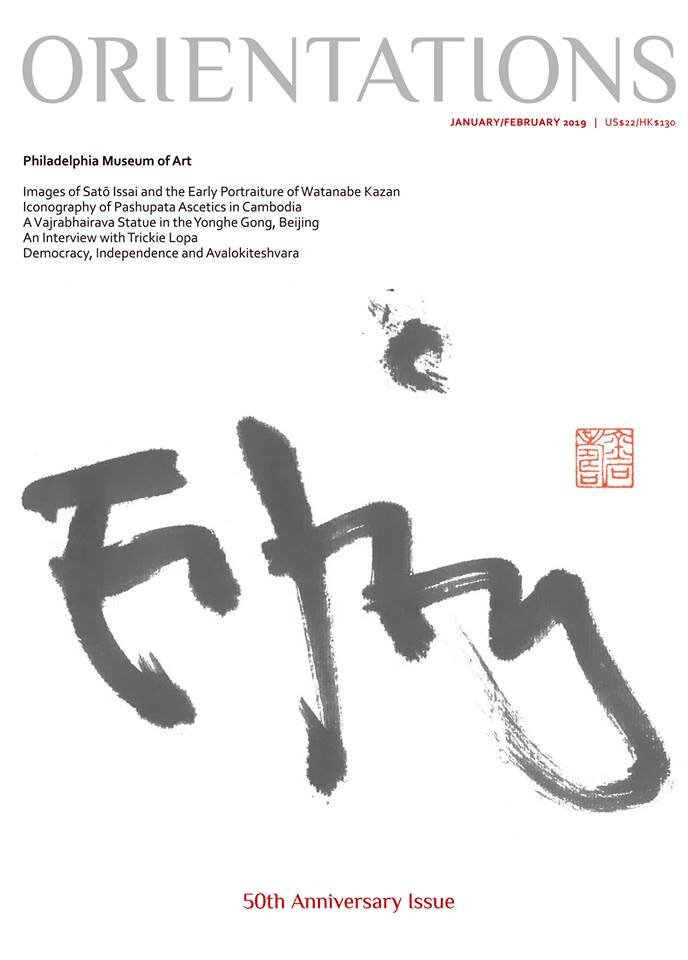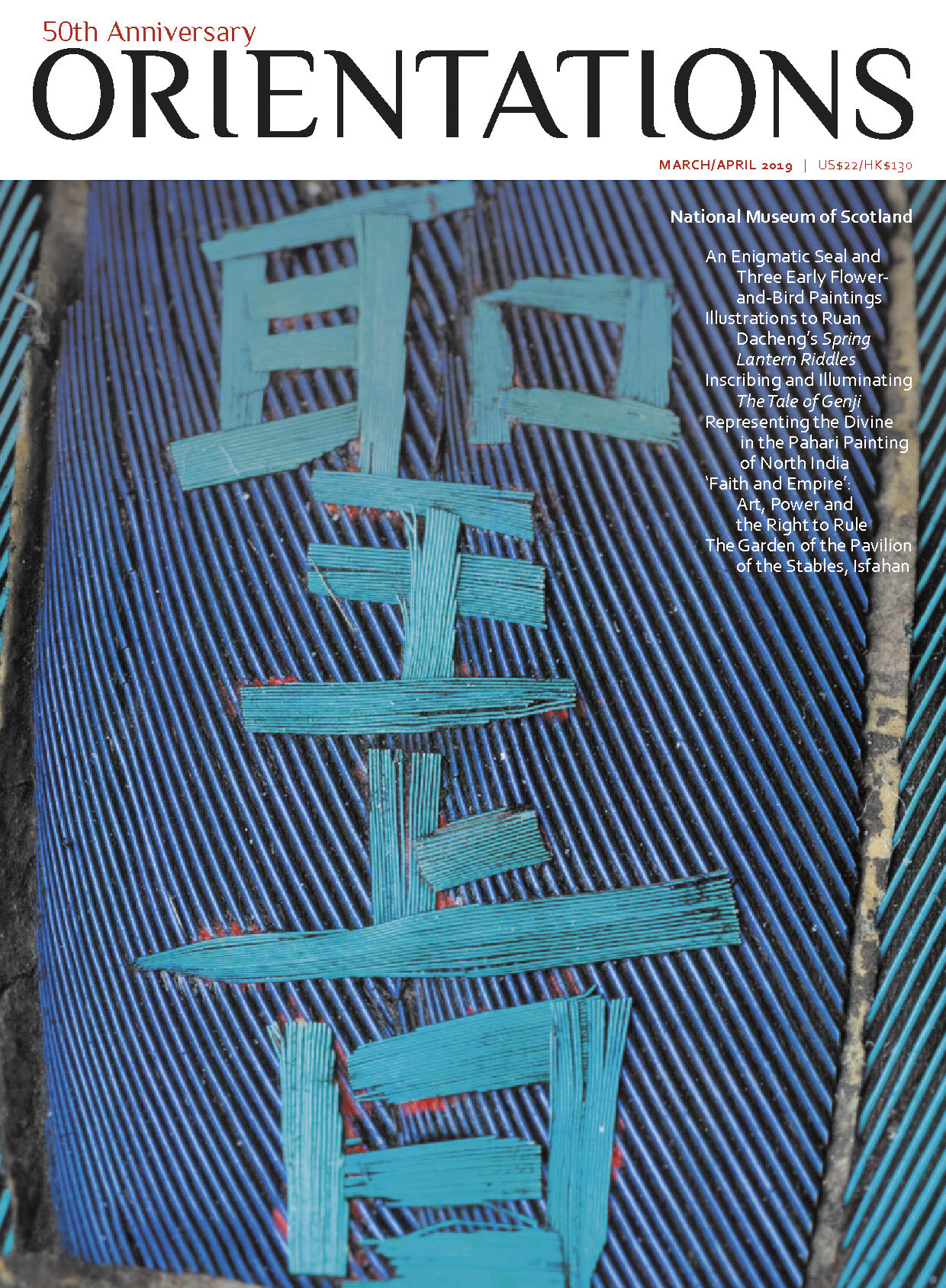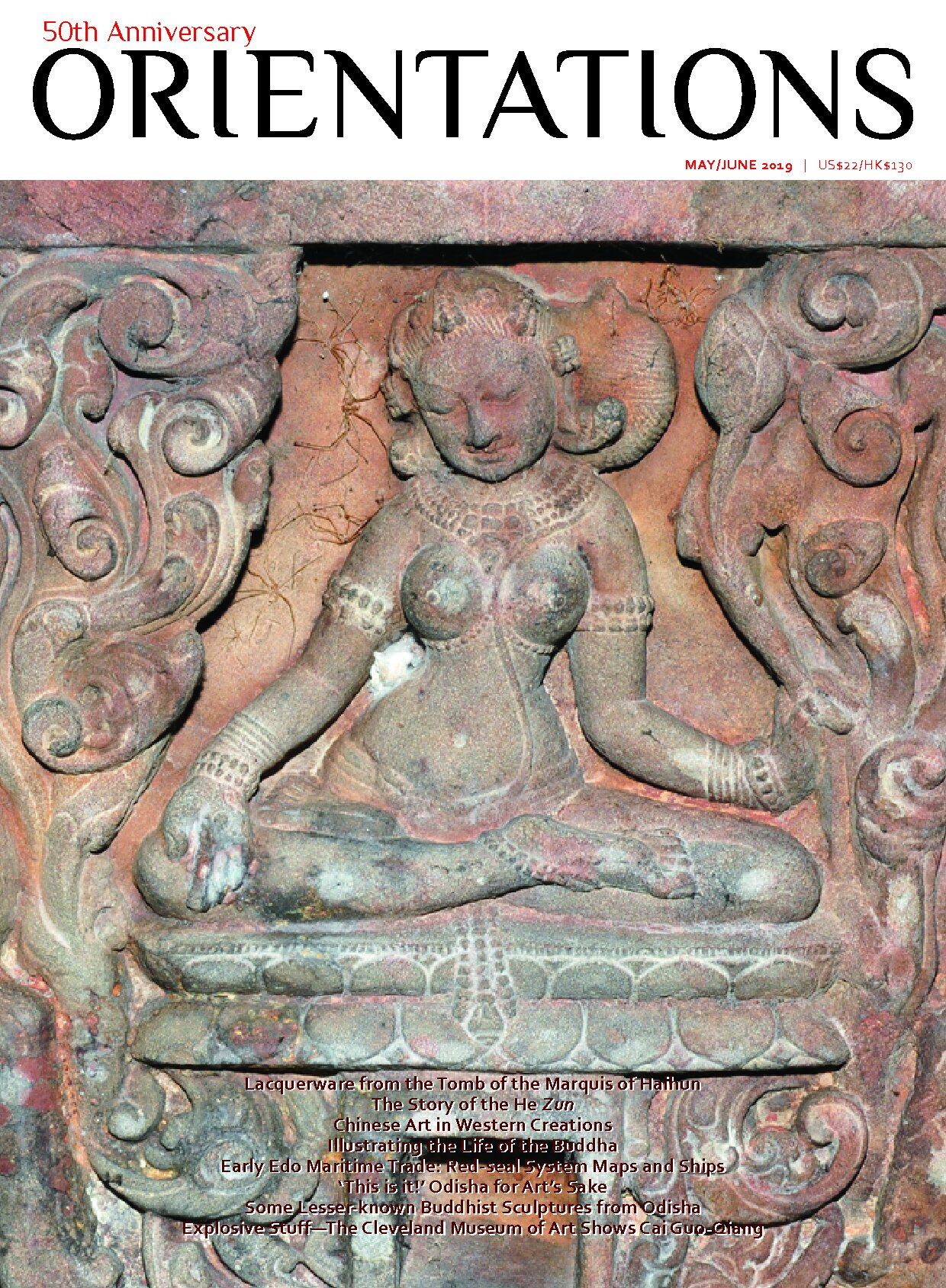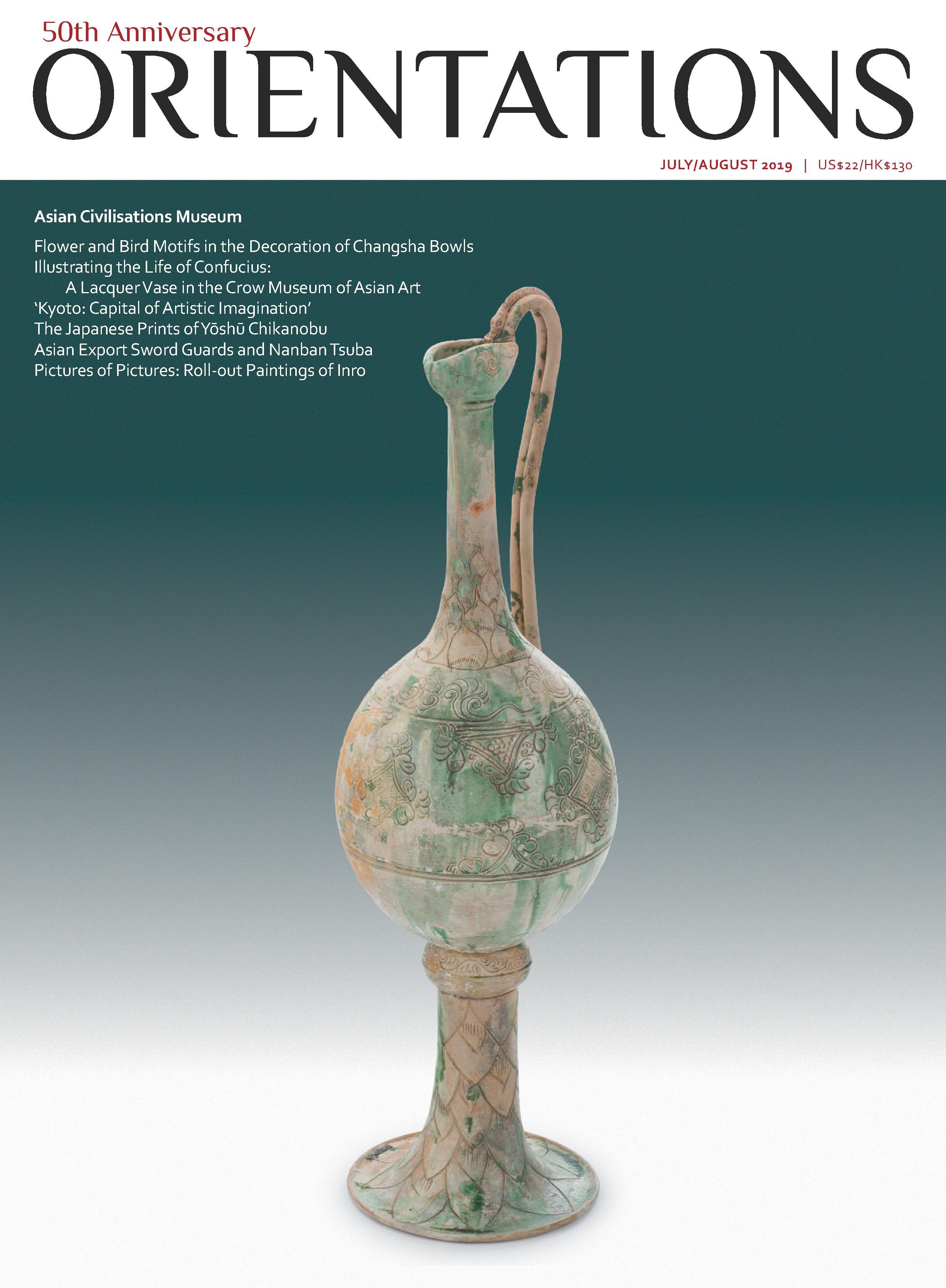NOV/DEC 2019
VOLUME 50 - NUMBER 6
In this issue we feature articles covering a number of Asian regions, namely China, Japan, Korea, India and Myanmar. The first article, by Quanyu Wang, Yi Chen and Rongyu Su, is a groundbreaking study of some of the Houma bronzes in The British Museum. In 2018, a scientific examination was made of these bronzes, including microscopy and X-radiography, in order to better understand their construction in relation to the pattern-block method of production. The article details the sometimes surprising results.
Next we turn to Buddhist art, with Katherine Anne Paul’s discussion of the merits of Japanese Buddhist art of the Edo and Meiji periods—a subject all too often ignored. Chin-Sung Chang focuses on a Korean gilt-bronze statue of Avalokiteshvara, found originally by a farmer in Korea in 1907 and rediscovered last year in a private collection in Japan. The image epitomizes the sophisticated Buddhist art of the Baekje kingdom, and is inseparable from the flourishing of the Pure Land tradition.
Two articles in this issue relate to weaponry. Rachel Parikh presents weapons and imagery from the Harvard Art Museums’ collection that are connected with the hunt in South Asia, where the practice was an important part of kingship. Cristophe Munier-Gaillard examines depictions of Portuguese in the Buddhist murals of Myanmar. Frequently shown carrying firearms, they played a role in the moral teachings of these paintings.
The musk deer is an unusual creature that once inhabited north China. Its musk was regarded as having significant medicinal properties, sparking renewed interest in the animal in 18th century England. Kristina Kleutghen discusses a painting of the musk deer by Ignatius Sichelbarth, S. J., an artist at the Qianlong emperor’s court, which was sent to the Royal Society in 1750 and engraved for publication in its Philosophical Translations. Missionary painters at the Chinese imperial court are also the subject of Hugh Moss’s article, which explores an unusual group of paintings depicting snuff bottles. Our feature articles conclude with Kim Inhye’s look at the work of the Dansaekhwa (Korean monochrome painting) master Yun Hyong-keun, currently featured in a retrospective at Palazzo Fortuny in Venice.
FEATURES
Quanyu Wang, Yi Chen and Rongyu Su. Houma Bronzes in The British Museum: A Technical Study
Katherine Anne Paul. Extending Enlightenment: Buddhist Art of Meiji and Edo Japan
Chin-Sung Chang. The Charming Smile of the Compassionate Bodhisattva: A Recently Rediscovered Korean Standing Figure of Avalokiteśvara
Rachel Parikh. The Thrill and the Peril: The Royal Hunt in India at the Harvard Art Museums
Cristophe Munier-Gaillard. Depictions of Portuguese in Burmese Buddhist Murals
Kristina Kleutghen. Exotic Medicine: How Ignatius Sichelbarth's Painting of a Musk Deer Appeared in the Philosophical Transactions
Hugh Moss. By Imperial Design
Kim Inhye. Umber and Blue: The Art of Yun Hyong-keun
REVIEWS
Mary Ann Rogers. ‘Contemporary Landscapes: Li Huayi’ at Honolulu Museum of Art
Yeewan Koon. Chinese Painting and Its Audiences
VOLUME 50 - NUMBER 6
In this issue we feature articles covering a number of Asian regions, namely China, Japan, Korea, India and Myanmar. The first article, by Quanyu Wang, Yi Chen and Rongyu Su, is a groundbreaking study of some of the Houma bronzes in The British Museum. In 2018, a scientific examination was made of these bronzes, including microscopy and X-radiography, in order to better understand their construction in relation to the pattern-block method of production. The article details the sometimes surprising results.
Next we turn to Buddhist art, with Katherine Anne Paul’s discussion of the merits of Japanese Buddhist art of the Edo and Meiji periods—a subject all too often ignored. Chin-Sung Chang focuses on a Korean gilt-bronze statue of Avalokiteshvara, found originally by a farmer in Korea in 1907 and rediscovered last year in a private collection in Japan. The image epitomizes the sophisticated Buddhist art of the Baekje kingdom, and is inseparable from the flourishing of the Pure Land tradition.
Two articles in this issue relate to weaponry. Rachel Parikh presents weapons and imagery from the Harvard Art Museums’ collection that are connected with the hunt in South Asia, where the practice was an important part of kingship. Cristophe Munier-Gaillard examines depictions of Portuguese in the Buddhist murals of Myanmar. Frequently shown carrying firearms, they played a role in the moral teachings of these paintings.
The musk deer is an unusual creature that once inhabited north China. Its musk was regarded as having significant medicinal properties, sparking renewed interest in the animal in 18th century England. Kristina Kleutghen discusses a painting of the musk deer by Ignatius Sichelbarth, S. J., an artist at the Qianlong emperor’s court, which was sent to the Royal Society in 1750 and engraved for publication in its Philosophical Translations. Missionary painters at the Chinese imperial court are also the subject of Hugh Moss’s article, which explores an unusual group of paintings depicting snuff bottles. Our feature articles conclude with Kim Inhye’s look at the work of the Dansaekhwa (Korean monochrome painting) master Yun Hyong-keun, currently featured in a retrospective at Palazzo Fortuny in Venice.
FEATURES
Quanyu Wang, Yi Chen and Rongyu Su. Houma Bronzes in The British Museum: A Technical Study
Katherine Anne Paul. Extending Enlightenment: Buddhist Art of Meiji and Edo Japan
Chin-Sung Chang. The Charming Smile of the Compassionate Bodhisattva: A Recently Rediscovered Korean Standing Figure of Avalokiteśvara
Rachel Parikh. The Thrill and the Peril: The Royal Hunt in India at the Harvard Art Museums
Cristophe Munier-Gaillard. Depictions of Portuguese in Burmese Buddhist Murals
Kristina Kleutghen. Exotic Medicine: How Ignatius Sichelbarth's Painting of a Musk Deer Appeared in the Philosophical Transactions
Hugh Moss. By Imperial Design
Kim Inhye. Umber and Blue: The Art of Yun Hyong-keun
REVIEWS
Mary Ann Rogers. ‘Contemporary Landscapes: Li Huayi’ at Honolulu Museum of Art
Yeewan Koon. Chinese Painting and Its Audiences
VOLUME 50 - NUMBER 6
In this issue we feature articles covering a number of Asian regions, namely China, Japan, Korea, India and Myanmar. The first article, by Quanyu Wang, Yi Chen and Rongyu Su, is a groundbreaking study of some of the Houma bronzes in The British Museum. In 2018, a scientific examination was made of these bronzes, including microscopy and X-radiography, in order to better understand their construction in relation to the pattern-block method of production. The article details the sometimes surprising results.
Next we turn to Buddhist art, with Katherine Anne Paul’s discussion of the merits of Japanese Buddhist art of the Edo and Meiji periods—a subject all too often ignored. Chin-Sung Chang focuses on a Korean gilt-bronze statue of Avalokiteshvara, found originally by a farmer in Korea in 1907 and rediscovered last year in a private collection in Japan. The image epitomizes the sophisticated Buddhist art of the Baekje kingdom, and is inseparable from the flourishing of the Pure Land tradition.
Two articles in this issue relate to weaponry. Rachel Parikh presents weapons and imagery from the Harvard Art Museums’ collection that are connected with the hunt in South Asia, where the practice was an important part of kingship. Cristophe Munier-Gaillard examines depictions of Portuguese in the Buddhist murals of Myanmar. Frequently shown carrying firearms, they played a role in the moral teachings of these paintings.
The musk deer is an unusual creature that once inhabited north China. Its musk was regarded as having significant medicinal properties, sparking renewed interest in the animal in 18th century England. Kristina Kleutghen discusses a painting of the musk deer by Ignatius Sichelbarth, S. J., an artist at the Qianlong emperor’s court, which was sent to the Royal Society in 1750 and engraved for publication in its Philosophical Translations. Missionary painters at the Chinese imperial court are also the subject of Hugh Moss’s article, which explores an unusual group of paintings depicting snuff bottles. Our feature articles conclude with Kim Inhye’s look at the work of the Dansaekhwa (Korean monochrome painting) master Yun Hyong-keun, currently featured in a retrospective at Palazzo Fortuny in Venice.
FEATURES
Quanyu Wang, Yi Chen and Rongyu Su. Houma Bronzes in The British Museum: A Technical Study
Katherine Anne Paul. Extending Enlightenment: Buddhist Art of Meiji and Edo Japan
Chin-Sung Chang. The Charming Smile of the Compassionate Bodhisattva: A Recently Rediscovered Korean Standing Figure of Avalokiteśvara
Rachel Parikh. The Thrill and the Peril: The Royal Hunt in India at the Harvard Art Museums
Cristophe Munier-Gaillard. Depictions of Portuguese in Burmese Buddhist Murals
Kristina Kleutghen. Exotic Medicine: How Ignatius Sichelbarth's Painting of a Musk Deer Appeared in the Philosophical Transactions
Hugh Moss. By Imperial Design
Kim Inhye. Umber and Blue: The Art of Yun Hyong-keun
REVIEWS
Mary Ann Rogers. ‘Contemporary Landscapes: Li Huayi’ at Honolulu Museum of Art
Yeewan Koon. Chinese Painting and Its Audiences

